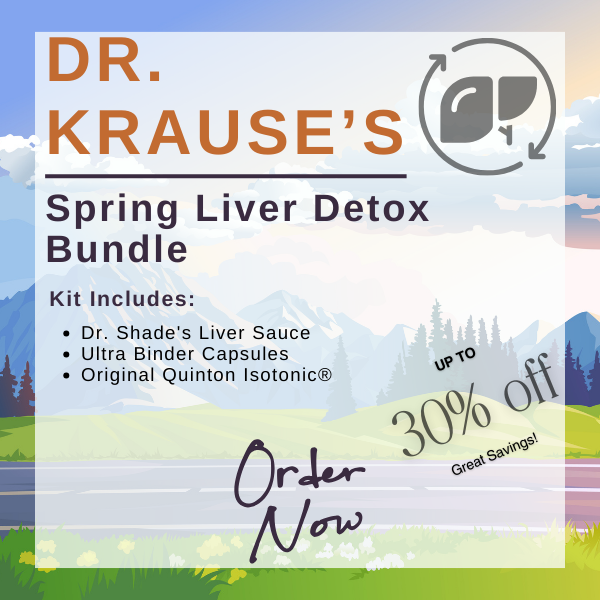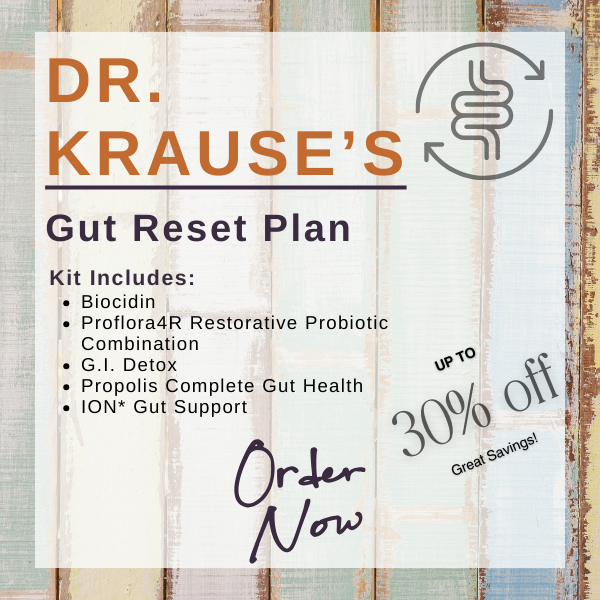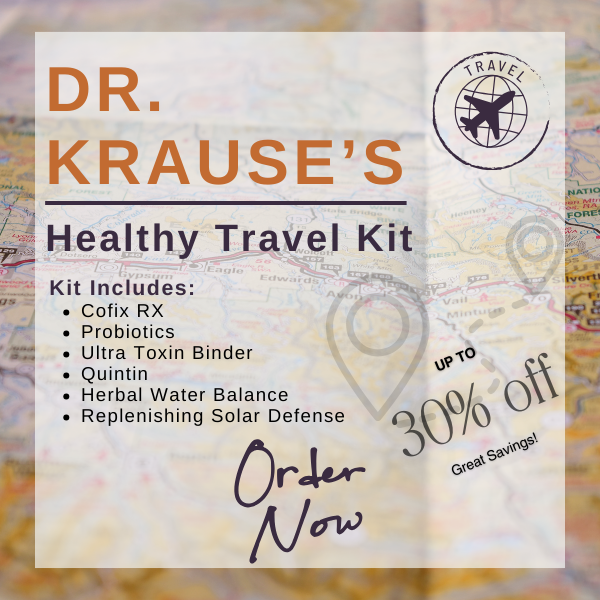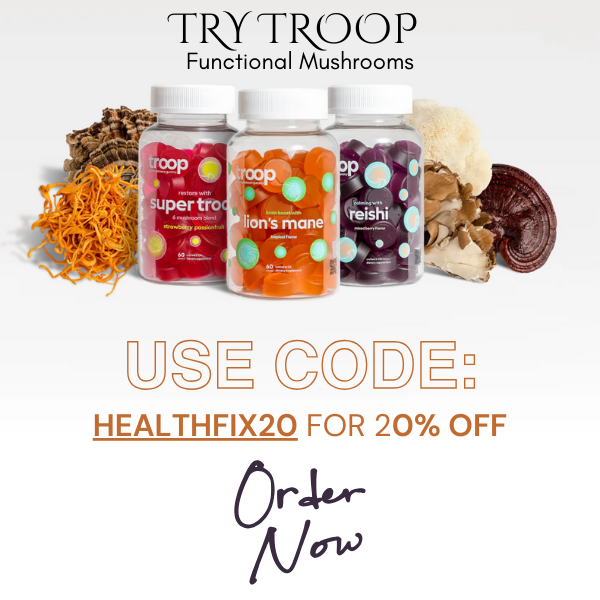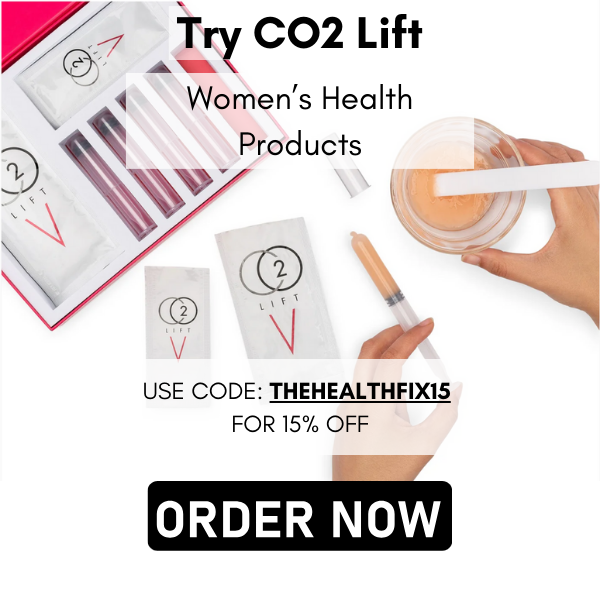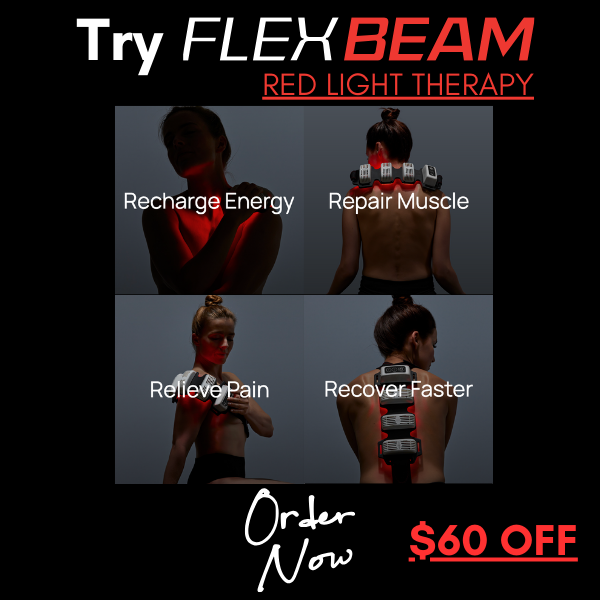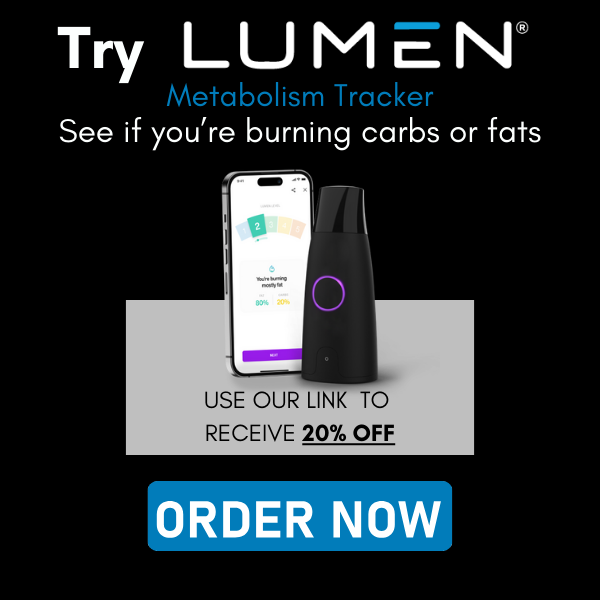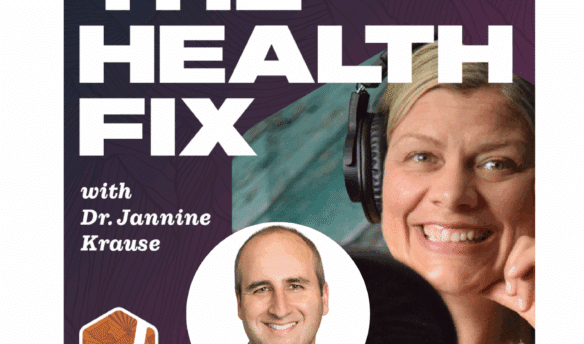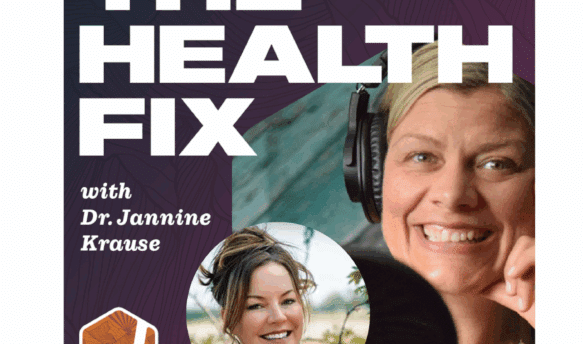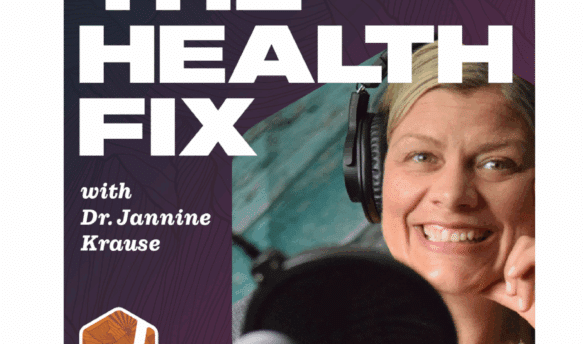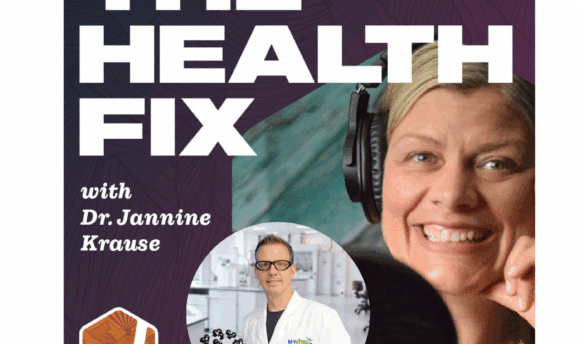Indoor air quality can be one of the biggest sources of chronic illness. From mold to dust mites and other allergens your lungs are processing all these things 24/7. Many put off or forget to change the filters in their home and car. By improving the quality of air in your home, car and even work you will allow your lungs to filter allergens more effectively as well as improve oxygen circulation throughout your body to boost your energy and vitality. Leo Tonkin is a cancer survivor and the founder of SALT Chamber, the world’s leading salt therapy product, equipment, and decor company. For over a decade Leo’s company has created and supported an entire industry for providing a safe, drug-free, evidence-based modality that is ‘hacking’ into our respiratory system to enhance performance and recovery while extending longevity and quality of life. In this episode of The Health Fix Podcast, Dr. Jannine Krause interviews Leo Tonkin on salt therapy and it’s many benefits.
Dr. Krause’s Protocols
Instructions Included
Traveling soon? Looking to detox or reset your gut? Try one of Dr. Krause’s Fullscript plans.
What You’ll Learn In This Episode:
- How salt therapy is a detox for your lungs and body
- Moist vs dry salt therapy
- How salt binds and clears the bugs and allergens that hang out in mucus
- The ability of salt to get into your skin and de-inflame your body
- Salt therapy for eczema and psoriasis
- Increasing lung function, volume and cardiovascular capabilities
Resources From The Show:
Salt Chamber – saltchamberinc.com
For 10% off of any salt therapy products – enter code: DRKRAUSE10
Give them a call: 1-855-luv-salt
Our Partners
Podcast Transcript:
JANNINE: [Intro] Welcome to the Health Fix Podcast, where health junkies get their weekly
fix of tips, tools, and techniques to have limitless energy, sharp minds, and fit
physiques for life.
Hey health junkies on this episode of the Health Fix Podcast.
I’m interviewing Leo Tonkin.
We’re going to be talking all about salt therapy, otherwise known as Halotherapy.
Leo started Salt Chamber, the world’s leading salt therapy product equipment and decor company
over a decade ago, and he has created an entire industry for providing safe, drug-free,
evidence-based salt therapy to help with your respiratory system. Now, let’s face it, we live
in indoor environments that are kind of toxic with mold infections on the rise and the pandemic
and different kinds of things going on with other bacteria’s and critters, you know, salt
might actually be something to look into. Now, even athletes are using it for recovery and helping
with their lung capacities and helping with their cardiovascular conditioning as well. So,
this is a fascinating topic, really excited to interview Leo because I’ve heard news things
about salt therapy for years, but never actually had a chance to dive into the details.
So let’s introduce you to Leo Tonkin.
Hey, health junkies.
I have Leo Tonkin on today.
And we’re going to be talking about salt therapy,
something that I’ve been familiar with.
I’ve heard of salt chambers, heard of salt caves in Europe
and excited to actually talk about it for once.
So Leo, welcome to the Health Fix Podcast.
LEO: Thank you very much.
Appreciate you having me on.
JANNINE: Well, salt therapy is something that I was introduced to
as a naturopath.
That’s kind of one of those things
that we learned about for respiratory conditions.
And now, of course, with the pandemic, it’s been one of those things we’ve been thinking about.
But one of the fascinating things that you kind of brought up in one of my videos I saw on you,
that I was watching, was a lot of people suspect that these little salt lamps can do
something for them. But that might not be the case. So I’d love for you to dispel some myths
today. And we’ll talk also about how you got into salt therapy, too, here in all that.
LEO: Yeah, sure. When I first got into salt therapy, also known as Halotherapy,
I really was surprised I didn’t care about it. I grew up in… I thought it was a physician,
grew up in a unique environment. And I thought also that when the Himalayan salt lamps, a lot of
people were promoting them as something that would absorb impurities in the air or create negative
ions. And when we first started building salt rooms, including Himalayan salt, which is a great
ambiance, we did the research and actually there was a class action lawsuit against one of the
manufacturers of the lamps where they were making claims, people with allergies and such. And
maybe from a placebo effect, it may have worked, but there’s no health benefits from having those.
It is a crystal. It is a natural element. It does have a tonic frequency. So if you put
tons of salt in a room on the floor or in a cave, like I think you do alter the energy in the room,
not to get too off the engine in terms of respiratory or skin benefit, not a nothing.
JANNINE: Wow. And you know, and that’s something that, you know, that’s kind of everybody’s first
introduction to to Halotherapy and salt therapy. We kind of we kind of been sold on these lamps
and I like the ambiance of them no doubt but obviously if I’m spending money on something
and it’s in my office I want to make sure that I get the most out of of what I’m putting my money
into. Now one of the things that you had mentioned in a couple podcasts and something that I’m really
interested in is is indoor air health and how we can improve things because we’ve got a lot
of folks talking about vaporizers and essential oils, but I’m also thinking, okay, what about
purification? What about things we can do in that department? So, so give us a little scoop there
and how you got into helping with indoor air.
LEO: You know, when we started Salt Chamber, it really
was more for skin and lung health and respiratory wellness. And primarily when you start looking
at how many people have allergies, asthma, bronchitis, COPD, cystic fibrosis, lung cancer,
the list goes on. And while halo therapy is a great, alt complimentary, natural modality,
it really doesn’t get to the source of the problem. What is, why is it that we have so many people
that have a respiratory condition or getting the cold or flu? And just like the pandemic that you
mentioned, there are amazing amounts of airborne pathogens, allergens, bacteria in the air that
we breathe. And you just start looking at the wildfires that have happened, and you look at the
quality of the air. Now that you have 8 billion people on the planet, you start to wonder.
And so the World Health Organization actually says that there’s about 90% of the world’s
population lives in poor air quality. And it’s not just outdoor to your point, it’s indoor.
And part of it is our HVAC systems. So if you think of your lungs, and when you breathe
things in, you have a kind of a built-in filter system through your nose and through your airways.
You have these structures of these aviolis and such that trap what you breathe in. That’s like our
filter system. Similarly, your HVAC system is like the lungs of your house or your school or
your home. So the question becomes, what are you doing for that air? Do you have an air purifier
monitoring the quality of the year. How often do you change your filters and what filters are you
using? What chemicals are you using when you clean your house or what are you cooked with?
And so it’s invisible that we don’t see it. Many people when you have the sun coming into your
house and you see that dust from how you see, you know, that’s what we’re breathing in, folks,
the dander, the dust, these little microbes of everything. So you start to see, wow, am I being
proactive in taking care of my lungs and salt therapy is like a toothbrush to your respiratory
system.
JANNINE: Interesting. So it’s pulling things out scrubbing, helping you scrub things. Tell us more.
LEO: A lot of people are familiar with salt as a therapeutic modality. It was used as a preservative
many years ago in the lieu of refrigeration. Why? Well, nothing grows on salt. Salt kills
as a surface. And it’s amazing. People use it as a saline solution for your eyes or contact.
Why? Because it is antimicrobial. It’s anti… So salt is a very pure product.
People are familiar with going to the ocean. That’s more of a moist salt when you breathe it in.
People refuse netty pots. So salt is something that really is good for you. A lot of people think
salt might not be and that might be true for digestion or hypertension or high blood pressure.
But breathing in a dry salt particle is what makes Halotherapy distinct. It’s a dry
particle. So because it’s dry, it absorbs what’s inside your lungs or on your skin.
And the particles are so small that they penetrate deep. So your hair is about 50 microns.
in diameter. These salt particles are less than one micron so they get deep in the respiratory
system and just like you put salt on the piece of eggplant, it pulls the moisture out, that’s
what it’s doing. So it’s going to pull out the stuff that gets trapped in your phlegm
and your mucus and the crystals of the salt kind of scrub it, clean it out. So you either
to bring it up or you’ll pass through your urine system.
JANNINE: Wow.
I don’t think many people would think of it that way, right?
Most of us are kind of stuck in the, okay, salt.
We use it for food.
Maybe some folks have gotten to the point
where the electrolytes and signaling within their body,
but not as an agent to grab things and pull it out.
So of course, the next question becomes,
okay, what kind of salt is this?
And tell us more about your devices to help you
to get the salt into the air.
LEO: Yeah, um, it’s not going to the grocery store and using your kosher salt or Morton salt and it’s not Himalayan salt or sea salt or there’s a dead, you know, dead sea salt or anything.
There’s a lot of varieties of salt around the world.
where this evolved from was really Eastern Europe
in the salt mines underground.
And back in the 1800s, they were chiseling and grinding salt
and it created a salt dust in the air.
And this is what the workers were breathing in all day long.
And you know what?
They started to notice that they were healthier
in their communities.
When they had their version of the pandemic,
whether it’s a bubonic plague or this or that,
they stayed healthy.
So they started doing research.
And then back in the ’70s, last century,
there was a piece of equipment called the halo generator.
Halo is the Greek word for salt.
And it’s a device that takes pure-grade sodium chloride.
So it’s a special salt that comes from the earth,
the land and the sea and the salt lake beds.
But it gets purified to strip it from any non-soluble minerals and elements.
And it’s what they make, if you went to the hospital, saline solution from it’s a dry
salt, 99.99% pure.
And it goes into this device and it grinds it into a very fine dry salt aerosol that
think it dispersed inside of an enclosed room or a booth or some chamber. And that’s what
people are doing at spas and wellness facilities and integrated and functional doctor’s offices
and all over where they’re now becoming more aware of how important you can treat as well
as prevent all types of respiratory conditions. So it’s breathing in this pure gray dry salt
air.
JANNINE: Wow. That’s, I mean, it’s super fascinating. And I think for a lot of people, they might be
thinking too, like, okay, Leo, so, so you’re getting this, this grade, this, this 99, 0.9%
salt. Where, where’s your favorite place from to get it from? Where, where are you getting
the salt from? Where are your salt mines? Let’s, let’s go.
LEO: Am I getting salted? Well– JANNINE: yes.
I’ve been to Poland to the salt mines there, and it’s pretty amazing. It’s like a whole
city underground, all carved out of salt. But we have a showroom here in Boca Raton, Florida,
and we’ve designed and built about 3,000 facilities all over the country.
And there are all types of, uh, from not resorts, like, uh, the Ritz Carlton and the
four seasons to those community wellness centers, to fitness centers. So really, there’s all kinds
of places. There’s actually a whole association by the salt therapy association that has a
directory. So for some of your listeners, they can go to there and find one of the salt therapy
facilities near you. But for me, I have it right here in my showroom, and I have a little portable
device that we designed just for the home market with a pop-up tent that you sit in for about 10
minutes. It’s safe for kids, children, moms love it because, you know, it’s cold season. It’s the
wintertime, you know, how often kids are getting sick in school. So I take this portable unit with
me and I do it when I’m in a hotel room, which many people know the air inside of those hotels
can be really tough, especially if you have conditions, which is why my voice is sounding
a little bit the way it is, because I was in a hotel last week, but I just sit in the shower stall
and put the salt in the air, and that’s what I do when I travel. It’s very great.
JANNINE: Oh, wow. This is something that kind of makes me think about some of my patients who are sensitive,
have allergies, but also I’ve got a lot of patients who have mold sensitivities in my practice and
thinking of them and some of our flight attendants who travel and I’m going, “Oh, wow, this would be a
great, great thing for them to be able to use.”
LEO: Yeah, I mean, everybody can benefit. It’s not just
that you need any kind of respiratory condition, but when you do think about what we breathe in,
statistically, our lungs start to stop developing when we’re in our early 30s.
And when you talk about longevity, there was a study done, John Hopkins back in the 80s,
they determined that the single most impactful thing that can impact the longevity of your life
and the quality of your life is your ability to breathe. If you can’t breathe well,
you’re going to have struggles, whether it’s walking up the stairs, playing around a golf,
pick up your grandkids or just doing any kind of things. And so that’s why if you turn on the
evening news and look at the national television commercials, what are you saying? Pharmaceutical
companies, allergy, asthma, so that our current medical system is designed to keep you addicted
to steroid inhalers, and taking pills all the time.
And for some people, I get it.
But we’re evolving in the medical world, and technology and science is really creating
breakthroughs, and you’re starting to see pulmonologists, respiratory therapists, ENT,
and obviously, naturopathic integrated functional physicians and just all kinds of people finding
out and being more aware. I had no idea about it…Ten years ago, I learned about it from
somebody from Eastern Europe. And I was like, wow. And then when I looked into North America,
there was less than 12 places in the country that was offering this. And so I started salt
chamber when I wanted to retire. And here we are almost 12 years later. And still, people
aren’t aware of it. So there’s a long road to go in creating
awareness. But to your point in the beginning, the pandemic
put a big spotlight on respiratory. And often, we don’t
think about things until something’s wrong or broken. You
know, and this is something that we need to embrace now. Because
unfortunately, there probably will be another pandemic.
JANNINE: Yep. Sadly, sadly, that is my suspicion as well. And, and you know, having something like the pop
of tent at me. Awesome. Because, you know, I love the concept of being able to go to the spot and
being able to, you know, purify the body, get some body work, have a salt room, but being able to do
something day in day out, I think is even more incredible for folks as well. So, so give us a
little more you had described you could put it in in the hotel room in in the tub area,
give us like how big is it some dimensions give folks a little visual so they know kind of what
we’re talking about and and give us a little more scoop on on how we take the salt and a little
generator that that kicks out the salt because I think that might be the the halo generators I’d
love to hear about that and I got a couple other questions on that of course.
LEO: It’s actually pretty
simple. The pop-up tent kind of folds up. Some people have seen these things that when you go to
watch a soccer game out in the rain and you pop up this little camping tent, it’s really kind of
small and it fits very well. And the halo generator is designed and it’s manufactured actually
to medical standards. So we manufactured this where we manufacture blood pressure and nebulizer
equipment. It’s very high-end stainless steel. Salt can be corrosive so it’s very precise.
It’s about nine inches tall and about four inches diameter and basically we have these
individual packets kind of like a sugar packet and you just empty it in and it’s got a keyfob
that you turn on and it starts to grind and disperse the dry salt into the air and these
particles are so small that they start floating up and you really want to keep it enclosed because
you don’t want salt getting all over your house. You don’t want to get in your bedroom. You know,
some people go into a closet and do it, but this pop-up tent is something that you just can pop up,
you plug it, you plug in the halo generator and it goes. I mean, for people that are looking at
this as a new business opportunity or people that have a homeless facility or a massage or yoga,
You’re starting to see all types of environments building salt rooms. There are some places
around the country that you can do yoga and salt at the same time. You can do breath work.
You do guided meditation. There are just so many ways as a business model that is out there
and there’s so many spas and resorts and other places that people are going to
chiropractors, and so many more, putting in these, you know, commercial
think of a telephone booth. And for those of you who can recall what a telephone booth was,
JANNINE: Right?
LEO: Or a payphone. And you don’t have those really anymore.
JANNINE: No, I take pictures when I see them because it’s just like so
unique these days. Because yeah, that size of something is, you know, a great size. And speaking
of that, you know, kind of kind of the the paper and kind of booth or phone booth. I have seen a
couple will post there on your website about a suana and being able to kind of retrofit a sauna or
figure out how to add one to a sauna. Give us the scoop there because I think a lot of people right
now are going, how can I how can I incorporate this into something I’ve already got kind of like
you were saying layering layering the therapies.
LEO: Yeah layering and stacking different wellness
modalities is a great idea. We do have a retrofit kit that has a bracket for this to go into a sauna.
The thing you want to understand is do you have a traditional or an infrared? If it’s a traditional
sauna, you want to put like a cover on it so salt particles aren’t getting in. But the other
thing is and not to confuse people, you don’t want to do sauna and salt at the same time because
when you do a sauna, a lot of the detox benefits come from sweating. And so you’re introducing moisture
into the environment. And this is about dry salt. And so not only is your skin going to get crusty
and really bad if it’s moist, that’s why you want to be dry, you’re not going to get the skin
benefit. And one of the things that we did not talk about yet is that because these particles
are so small and they can penetrate deep into your respiratory. They also penetrate the first
layer of the epiderus. And so when you think about the characteristics of halo therapy,
which is that it’s super absorbent, pin dry, it’s antibacterial, right, and it’s anti-inflammatory.
That’s why when you breathe it in, it opens up the airways. So you’re breathing in more oxygen,
more oxygen to your red blood cells is going to increase your cardiovascular and that’s why athletes
are doing this as a treatment because it’s increasing lung function, lung volume, they’re using it for
recovery, re-imposed workout. But for the skin, you think about inflammation, that’s one of the
causes for people that have eczema or psoriasis to break up. So if you expose your skin to the dry
salt, it’s actually going to impact the skin rejuvenation. Think of people that might have
acne, the bacteria, it pulls out the oil. So to have more rigidity in the skin, you expose your
skin while you’re sitting in your sauna or salt booth or a salt boom, and you get that benefit
as well. And when you can just chill, even for 10 minutes, and do some mindfulness, and just do
focus on your breath, you kind of get to a different mental wellness as well. So I like
to think about it as mind, body and breath, which is what it’s all about.
JANNINE: Absolutely. Absolutely. I mean, the more we talk about breath work, the more we talk about how
connecting to our deeper energies, let’s put it that way or in our vibe. I mean, it’s so important.
and being able to have something that will add, like you were saying, stacking, I think is incredibly
huge. Now, here’s one interesting thing, and I’m curious about this because I’ve been noticing
this over and over again in my labs when I work with folks, I keep seeing sodium actually being
low on chemistry panels over and over again. Have you seen any results with researchers
had anyone else talk about that connection to possibly chemical air pollution or just stress in
general?
LEO: Yeah, I think, you know, I think there’s been a perception that salt is bad for you.
Yeah. And, you know, the first thing, you know, I do when I wake up in the morning is I hydrate.
And I actually use a so-way mixture where I have Himalayan salt rocks in a jar of spring water
that saturates the water to a certain level that’s great for a pH balance. Some people may use things
like LMT, one of our partners, where it’s a package of sodium, has some magnesium and other
minerals in it. We need salt into our system, and I think salt has gotten a bad rap in the past,
and I think people need to learn more about how salt really is good for you.
Obviously, Halo therapy is breathing it in, which it doesn’t really impact any of your sodium
benchmarks or metrics per se or markers. But salt intake and understanding your metabolic
system and how salt gets into your system, I think more and more people need to learn about that.
And I think you’re starting to see how things like hypotonic saline solutions that have been
and utilize nebulizers that are just more of a moist salt.
I drink my sodium in my throughout the day.
I don’t think people really realize that.
Obviously, if you’re doing exercise,
you know, after you do a salt session,
we tell people, hydrate.
And I don’t think part of it has to do with that.
I reflushing our system out.
And salt’s really great for doing that.
You know, every pretty much every drug or supplement
that’s out there has some form of sodium chloride
’cause it’s a great transport system
for getting things into your blood system.
So that’s why if you drink salt water,
it’s gonna get throughout your system a lot faster.
JANNINE: Absolutely, absolutely.
I mean, it makes sense.
It makes sense.
I mean, there are so many different flushes, right?
Even your digestive flush with higher amounts of salt.
I think if we step back from it,
and one of the things I think a lot of folks have been,
like you said, brainwashed about salt is bad.
Don’t take extra salt in.
I think, like you said,
the pure salt is what you’re using.
A lot of folks are confused as to,
“Well, isn’t Morton’s or isn’t commercial salt pure?”
And this is something that I have to keep highlighting
over and over again, like,
no, there’s other things in it.
And so I’d love to hear your kind of spiel,
spiel on what you say as a blanket statement
for the difference between pure salt and table salt.
LEO: I think it depends on the purpose
of what you’re using salt for, right?
You live up in Wisconsin and when it’s iced over,
they put certain salt on the roads.
JANNINE: Yep.
LEO: There’s salt that we use.
You know, a lot of people, when Morton salt came out
with that, when I’m getting enough iodine.
Most salt products that are out there for consumption
is about 96 to 97% sodium chloride.
Himalayan salt, I use a lot in my own cooking.
We’ve even designed aging rooms for meat
where they have salt, Himalayan,
salt bricks in there that kind of evaporate
with the humidity to help tenderize and flavor the meat.
That’s why it was used as a preservative back in the day
and why, you know, if you watch the food channel,
It’s always about getting the right seasoning of salt,
salt’s good for protein.
So same with in our system.
It’s all about the proteins that we have in our system.
So most of the salt that’s out there
is pretty much good salt to eat.
You wanna look to see if it’s a natural,
if there’s any additives to it.
That’s why I like to use just pure Himalayan salt.
We don’t use it in the halo generator
because some of these salts could have other minerals
and get stuck in your respiratory system
that are not water soluble.
The sodium chloride we have,
you really don’t wanna use it as a food salt
because you need some aspect of the coating on the salt.
So whether it’s a organic salt or, you know,
most salt is, you know, salt’s not man-made.
So Redmond salt from Utah,
You’ve got different salts around,
there’s over hundreds of varieties of where salt comes from,
but you wanna take a look at the purification,
but there’s salt from Africa,
there’s salt from the Middle East,
there’s salt Caribbean salt, Dead Sea salt.
Some say that it’s great for more of a bath, right?
Epsom salt, for example,
some of your listeners may be into flotation
and what they utilize for salt therapy,
where you put, you know, 800 pounds of Epsom salt
in this kind of a tub that you float in.
And that’s always been good for you as well.
It’s foot salt baths, other salt baths that are out there.
So all kinds of salt,
but the salt that you breathe in is a pure grade salt.
JANNINE: I was hoping you kind of go down that route
to kind of give us the breakdown.
‘Cause I mean, I think a lot of people,
if they invest in a halo generator,
they’re gonna know that like, okay, you know,
we’ve got to use this one type of salt,
but I think it’s important to keep that,
that distinguishment out there because the salts
with minerals, obviously we don’t want minerals
getting stuck in the lungs, we wanna make sure
that we’re using the purest possibility out there.
Now, I’m super intrigued.
I love spas, I used to own one myself.
And I know that with the salt chamber,
you’ve got a list of different folks out there
and you even were able to rattle off the Sundara spot here.
in Wisconsin. I’m, I’m very curious with that. Can folks find all the spots you’ve worked
with on the Salt Chamber website or do you have a?
LEO: Yeah, so we do have a directory at saltchamberankinc.com. If you go to our resource page and go
down to our directory, you’ll see them all over the country and all over the world,
as well as the salttherapyassociation.org. They have a directory. Again,
And there’s probably around 4,000 facilities around the U.S. in Canada.
And this is something that’s just becoming more and more of a business model.
If you think about it, for those of you on the business side, putting in a salt booth
or designing a really cool salt room is not a large amount of money.
But the return on the investment, you don’t need a special license, you don’t need a licensed
therapist or anything, and the salt is costing you pennies.
And so a lot of people are going to facilities and they’re paying anywhere from $15 and $25
on the lower end up to packages where you’re going into a facility and getting a certain
amount of sessions a week or a month.
of them might have other modalities like infrared or cryotherapy or flotation or red
light or other modalities. So you do want to shop around and take a look at it. And
if you’re interested in that pop-up salt booth and checking that out, we’re going to give
all your listeners a 10% discount and they can go to salttherapyhome.com and see what
that portable units all about.
JANNINE: Awesome. Well, we’ll definitely make sure we get that folks in at doctorjkrausend.com
in the show notes. And I, of course, we’ll put it out on
Instagram as well. Now I, I’m, you know, having owned a spa before,
I always think about stacking things. Of course, I’m an acupuncturist as well.
And so I’m thinking how cool would it be to have, you know, the salt going during
acupuncture?
LEO: You can. There’s people that are doing that. They’re doing group acupuncture inside
salt rooms, they’re doing it individually.
You can actually take a treatment room
and make it into a multipurpose room,
where you can have the halo generator attached to the room.
And while you’re doing certain modalities,
obviously you don’t wanna have a lot of electronics
in a room ’cause these salt particles can get into,
let’s say a biocharger or a hydrophacial
or other type of equipment.
But massage and salt, acupuncture and salt,
breathwork, Rolfing, reflexology, Reiki.
So many things that people are doing.
So while you’re just sitting there,
I mean, we have facilities now that are specifically designed
where you’re doing IV hydration.
So while you’re getting your drip on,
you can get salted by breathing in the salt
while you’re lying there.
So a lot of interesting modalities
in this cool wellness space that we’re all in,
that we’re more into our self-care
and you have people like yourselves
that are really putting the word out there,
informing and education is I think the most important thing.
But a lot of ways that you could be utilizing it.
JANNINE: Oh my gosh, yeah, I have so many ways in my head
that I’m thinking about.
And plus, one thing, let’s talk about this for a second
because I think a lot of people have seen
the really cool spa rooms where the salt decor
and that’s one thing that you guys work with as well
on the walls and to a non-educated eye,
you think to yourself, oh,
everything’s coming out of the decor,
just like we had talked about before with the salt lamp.
And so I would love for you to talk about the decor,
how you can work it into things,
but also understanding that that’s not exactly
where the benefit’s coming from.
LEO: Right, I mean, people just love seeing
these backlit Himalayan brick walls.
They’re very, I mean, the color,
There’s two different ways you can do.
There’s the typical pinkish amber kind of color
that just creates a very,
for those that are into chromatherapy
or you looking at color therapy,
there is some real science behind that.
And so when you’re in that type of environment,
it just creates this kind of relaxation soothing.
There are people that are doing sound baths,
Himalayan bowls, crystal bowls,
while being in a salt room
that has the Himalayan salt on the floor.
So it looks like it’s a beach.
You know, you got this cool texture.
Some do it more cave-like,
where they’re taking chunks of these Himalayan lamps,
sort of that are cut and put into structures,
twinkle, skies, like you got.
I mean, you can get expensive, right?
A lot of people may just put one feature wall.
We take Himalayan salt as pricks.
They also are white Himalayan,
more pure, where you can put color lights behind them
and create different colors in doing it.
We do in our salt booths.
We have color therapy lights
where you have things in there.
So it’s just really beautiful.
You can put it in a sauna.
You’ll see a lot of saunas now
where they’re putting that as a decor.
but again, to your point, it’s only decor.
There’s no, even when you heat it up,
you’d really have to heat salt to about 1,500 degrees
to get the molecules to separate and create something,
but that’s not healthy.
So it’s just been a really cool decor element.
And when you’re looking at environments,
when you wanna take a timeout,
you wanna break, take a breath break,
you wanna take a mental timeout,
you want to do something that’s good for your skin
and your lungs, why not?
JANNINE: Right, I mean, I’m looking in my,
I do my podcast in my basement,
I’m looking over in this corner area,
I’m like wondering what to do with that space.
Maybe I need to create a little something in there.
So of course I’m going to ask now,
’cause I’m just curious what,
I know you’ve done a lot of different projects.
What’s been like one of your favorites
in terms of a spa or a space that is so relaxing
and just one of your favorite ones to create.
Give us a scoop.
LEO: Well, we just came back from being in New York
and there’s a facility there,
a hotel, a property called Virgin Hotel.
Many people know Virgin, Richard Branson in Virgin.
And there’s a new rebrand of a spa and fitness group
called Exhale.
And they just, Exhale just opened up their new flagship
the Virgin Hotel in New York City and they’re going to be opening up others and we created this
salt recovery lounge with them that has these really cool chairs from Oak Works where it’s this
sound vibration chair that you sit in and you’ve got this beautiful brick wall and you’ve got the
salt come and you could do an IV you could do compression like the Thera body you can do this
sleep mask, all of these modalities,
that you can just go and lie down and just exhale.
And it’s just really a cool thing.
They just opened up literally on Friday, very cool space.
And then there’s a couple that are on the West Coast
where they really created a really cool cave-like structures
that when you go in there, it’s like,
“Wow, think of Disney World.”
And you think of some of the events.
So we got some very creative people
are doing all kinds of things, really to create a place to go and relax. You know, all kinds of
spots had these relaxation rooms to sit in. Well, now how to be intentional? How to have the right
kind of music therapy? How do you get the senses involved in creating multi-sensory experiences
at home? And we’ve been doing residential projects. We did a beautiful salt room for Tony Robbins
here up in West Palm Beach. He’s got an amazing salt room that we did. And so there’s a lot of
very cool residential projects that people can do. Some have good budgets to do them,
but you can do something very simple. Just to your point, do one panel. We have people that use it
as a headboard in their bedroom or, you know, in other places. So it’s very cool as a decor
element. And we have designers on our team to help people figure that out.
JANNINE: Wow. That’s so fun. That’s so fun. Honey, you should mention
Exhale. I worked at Exhale, the old Exhale in Chicago before all of it
changed over. And it’s a great, great group. You know, I’m excited to
see how New York goes. But just having a space in your home for
relaxation and being able to design it, I think, is a fun, fun
place to start. And you know, like you were saying, it doesn’t have to be a lot of money
in this case. Now, of course, folks might be interested in going, okay, Leo, so can
they contact you guys? How do they contact you guys to be able to design something? We’re
looking for ideas.
LEO: No, I appreciate it. Yeah. Well, they for sure go to our website at saltchamberinc I-N-C .com
We’re salttherapyhome.com.
You can also call our toll free number at 855-love-salt.
That’s L-U-V-S-A-L-T.
So that’s 855-love-salt,
and we’re saltchamberinkinc.com.
JANNINE: Wow, well, you’ve inspired me to want to retrofit
some stuff in the back of my basement here,
and I know Spas, you know, around,
and anyone who might be listening right now
might be thinking like, oh, wow, there’s got to be some way we
can stack something in. And sounds like you guys are the folks
to get the scoop from. So, great stuff here. Can’t wait to to
share this one. And the pop up tent. Now, of course, that is that
is something that intrigues me as well. And for folks to kind of
take on the go, will you remind folks how they can find that
one and how they can connect with you everywhere you’re you’re
LEO: Yeah, no, yeah, absolutely. We’re on instant. We’re on social
media, look at salttherapyhome.com, you’ll see the pop up tent with the portable halo generator
that also has a sonic conversion kit for folks. And we’re going to give you all a 10% discount on
all of that. It has everything that you need to know there. And some folks are using it as a
business opportunity. They’re going to the schools, they’re going to doctors offices,
educating people about it. Bring it to your local health fair. Senior citizens are doing it.
Senior living facilities. I have so many friends of mine, like my mom is 84 and I bring it to her
and it’s, she just loves it. It clears her up. So there’s just so many possibilities. We have
moms with kids that are pre-asmatic or there’s, you know, there’s colds going around in school.
first sign of sniffles, pop that thing up, go in there. So check us out on Instagram and Facebook,
go to salttherapyhome.com. And if you got certain conditions, we’ve got great salt therapy
consultants on board to help you out as well.
JANNINE: Ooh, let’s talk about that for a second though,
because I mean, that I know we didn’t dive into all the different conditions that one can
can work with with this, but tell us about the sauna.
LEO: yeah I mean there’s so many ways that
respiratory affects people and we have a certified halo therapist program from the salt therapy
association that dives deep into the lung and respiratory system and when you start to look
at what are the some of the things that we can be doing to really take care of our lungs in a
proactive way there’s a lot of things that we need to be doing you know a lot of us are
mouth breathers, for example. How to do the right breath work. I know I had
cancer six years ago. I’m a survivor. I had a stage four tumor. I had a trache in
my throat, and I had learned how to eat and breathe differently as I was being
radiation and chemo. And I’m now in complete remission and cured, but I
learned a lot more deeper about the personal impact about how we breathe.
impacts are well-being and I think we take it for granted. We’re not aware of
our breath during the day and so there’s a lot of things to learn that can help
our breathing and there’s a lot of conditions that we don’t understand.
Everyone has that some form of allergies. Do people really understand what are
their triggers? What about the air filters? I mean I live here in Florida.
We run our air conditioning a lot right and we were told back in the day
Oh, change your filter every six months.
You got to be doing it every month and you got to have the right filter.
What is it rated for?
You have devices out there that are air filters in your home, get them.
Things like molecule or other products that are out there, air pure, different ones.
Get an air quality control system to monitor.
It’s just something that we’re not aware of until it’s kind of like our car from the
red light goes on.
Oops.
to go do something. But are we changing the oil regularly? What about even our car? You know,
there’s an air filter. Do you know what that brake dust and the rubber dust that is on our roads
that we breathe in all day long that we’re not aware of? It’s interesting. So it’s something
that should be top of mind. There’s not a lot of contraindications for doing salt therapy.
It’s safe. The only contraindications are people with certain stage of lung cancer.
You don’t want to expose open wounds to salt because it could sting a bit, right?
But other than that, I’ve got four grandkids and they’ve been doing salt since they’ve been six
months old. One particularly had a respiratory issue that had been born a little premature
he’s been in the salt booth. So you just use a lower concentration. Athletes are doing it
right before they’re going to work out, as well as play in sports opens up the airway,
more oxygen coming in. A lot of applications for so many people.
JANNINE: Well, I could think of a million. I mean, you know, more than just the relaxation,
I’m thinking folks with chronic sinus issues, which I see more and more. I’m thinking sleep apnea,
having something in your bedroom. Like you’re mentioning the headboard, I’m like, hmm, a whole
salt bedroom.
LEO: Right. Well, I mean, that’s one of the reasons I think, you know, Tony Robbins got
salt therapy because he was from sleep, you know, when salt anti-inflammatory. So when it
reduces the inflammation throughout your sino, you know, nasal cavity, all the way down to your,
you know, your esophagus down through your vocal cords and everything, it just reduces the
inflammation, which is one of the causes of sleep apnea.
And so people that are on, you know, sleep apachines or other things, we have people
that are doing that not using those anymore.
We have people that were on COPD on oxygen tanks, not using that often.
Same thing with steroid inhalers.
I’m not telling you that this is a replacement, but as you start getting your lungs healthier
and focus on respiratory,
you’ll see a big difference in the quality
and the longevity of your life.
JANNINE: Absolutely, absolutely.
I’ve no doubt, I’ve no doubt.
Wow, this has been a fabulous conversation
and I, you know, lots of things enlightened here
and I think a lot of folks are gonna be thinking differently
about how can they maybe incorporate some salt
into their world, if not dabbling in a spa first experience
and then seeing if it’s for you.
So thanks again, Leo, for coming on.
So much good information.
I sincerely appreciate it.
LEO: Oh, absolutely.
Thanks for having me on.
Look forward to hearing some feedback from your listeners.
JANNINE: I have no doubt that folks will love this.
And we’ll make sure guys that all of the websites,
all the details and your discount code
will be at doctorjkrausend.com.
Thanks, Leo.
Appreciate it.
LEO: You bet.
JANNINE: [Outro] (upbeat music) Hey, fellow health junkie.
Thanks for listening to The Health Fix Podcast.
If you enjoy tuning in, please help support me
to get the word out about the podcast.
Subscribe, rate, and review, and just get that word out.
Thanks again for listening.

